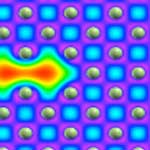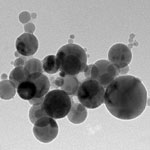Showing Spotlights 169 - 176 of 217 in category All (newest first):
 Why does silicon, which usually shatters catastrophically like glass when fractured, suddenly change and show ductile fracture like metals when the temperature is increased? Large atomistic models that incorporate quantum mechanical effects of how atoms interact in the material have now unravelled the fundamental events that cause the sudden change from brittle cleavage to ductile dislocation emission at a crack tip in silicon. This research has revealed that at low temperatures, silicon fails under spreading of cracks, where atomic bonds are broken continuously such that fractures spread easily in the material. For temperatures beyond a critical point, however, this changes dramatically and rather than breaking atomic bonds, stacked planes of atoms in the silicon lattice are sheared altogether, shutting down the spreading of cracks and giving rise to a much more graceful mode of failure that resembles that of metals.
Why does silicon, which usually shatters catastrophically like glass when fractured, suddenly change and show ductile fracture like metals when the temperature is increased? Large atomistic models that incorporate quantum mechanical effects of how atoms interact in the material have now unravelled the fundamental events that cause the sudden change from brittle cleavage to ductile dislocation emission at a crack tip in silicon. This research has revealed that at low temperatures, silicon fails under spreading of cracks, where atomic bonds are broken continuously such that fractures spread easily in the material. For temperatures beyond a critical point, however, this changes dramatically and rather than breaking atomic bonds, stacked planes of atoms in the silicon lattice are sheared altogether, shutting down the spreading of cracks and giving rise to a much more graceful mode of failure that resembles that of metals.
Jun 22nd, 2010
 'You cannot have an appropriate social dialogue on nanotechnology without an open-minded, consistent and even audacious communication roadmap aiming to bring everyone in.' So begins the foreword to a new Communication Roadmap by the European Commission on communicating nanotechnology in Europe. The EC has now compiled a roadmap for communicating nanotechnology across Europe. It presents the focus, objectives, methodology and actions already in place and to be developed over the next few years. The 188-page document is structured into three main parts: Where are we now? Where do we want to be? and How do we get there? and provides a detailed overview of all relevant activities and initiatives existing or planned across Europe.
'You cannot have an appropriate social dialogue on nanotechnology without an open-minded, consistent and even audacious communication roadmap aiming to bring everyone in.' So begins the foreword to a new Communication Roadmap by the European Commission on communicating nanotechnology in Europe. The EC has now compiled a roadmap for communicating nanotechnology across Europe. It presents the focus, objectives, methodology and actions already in place and to be developed over the next few years. The 188-page document is structured into three main parts: Where are we now? Where do we want to be? and How do we get there? and provides a detailed overview of all relevant activities and initiatives existing or planned across Europe.
Jun 14th, 2010
 A European project has completed an extensive five-year study of the needs and opportunities for coordinating future research and development in nanomaterials science and nanotechnology for the advancement of technologies ranging from communication and information, health and medicine, future energy, environment and climate change to transport and cultural heritage. Based on the collaborative work of more than 600 experts from all over the world, the project has compiled an overall picture of the present and future developments in the large spectrum of nanomaterials. Although one of the foci was to highlight the important roles of advanced analytical equipment at European research infrastructures, especially at synchrotron radiation, laser and neutron facilities, the 500-page project report provides an excellent overview of the nanomaterials revolution that is upon us. This is one of the best, up-to-date primers on nanotechnologies!
A European project has completed an extensive five-year study of the needs and opportunities for coordinating future research and development in nanomaterials science and nanotechnology for the advancement of technologies ranging from communication and information, health and medicine, future energy, environment and climate change to transport and cultural heritage. Based on the collaborative work of more than 600 experts from all over the world, the project has compiled an overall picture of the present and future developments in the large spectrum of nanomaterials. Although one of the foci was to highlight the important roles of advanced analytical equipment at European research infrastructures, especially at synchrotron radiation, laser and neutron facilities, the 500-page project report provides an excellent overview of the nanomaterials revolution that is upon us. This is one of the best, up-to-date primers on nanotechnologies!
Apr 29th, 2010
 One of the key issues in the young field of nanotoxicology is the lack of standards and definitions. Although there have been some efforts, there still is no coherent international approach to determining if and what risks are posed by what kind of nanotechnology materials. At the core of the problem are the serious challenges that are created when comparing test results and drawing conclusions without adequate standardization and nanomaterial characterization. Exemplifying this set of problems further, a new study shows that even the most basic set of data, the nanomaterial characterization information provided by the manufacturer, can't be relied on - something which shouldn't come as a complete surprise given the existing problems with characterization data.
One of the key issues in the young field of nanotoxicology is the lack of standards and definitions. Although there have been some efforts, there still is no coherent international approach to determining if and what risks are posed by what kind of nanotechnology materials. At the core of the problem are the serious challenges that are created when comparing test results and drawing conclusions without adequate standardization and nanomaterial characterization. Exemplifying this set of problems further, a new study shows that even the most basic set of data, the nanomaterial characterization information provided by the manufacturer, can't be relied on - something which shouldn't come as a complete surprise given the existing problems with characterization data.
Apr 27th, 2010
 Taking the patent land grab to a new level, the government of Greece today, April 1, filed a patent and trademark application for the term nanotechnology with the European Patent Office. The country is thereby seeking the right to prevent third parties from commercially exploiting these and related terms without paying royalties. Notwithstanding the moral high ground the Greek government is trying to occupy, observers note that the real reason for this surprising move is very simple and very down-to-earth: money. Cash-strapped Greece, on the brink of bankruptcy, is desperate for revenues. Greece's massive debt problem has shaken the entire euro zone and undermined the shared currency. Greece's public debt is so high that the country could default - with potentially dire results for the Euro.
Taking the patent land grab to a new level, the government of Greece today, April 1, filed a patent and trademark application for the term nanotechnology with the European Patent Office. The country is thereby seeking the right to prevent third parties from commercially exploiting these and related terms without paying royalties. Notwithstanding the moral high ground the Greek government is trying to occupy, observers note that the real reason for this surprising move is very simple and very down-to-earth: money. Cash-strapped Greece, on the brink of bankruptcy, is desperate for revenues. Greece's massive debt problem has shaken the entire euro zone and undermined the shared currency. Greece's public debt is so high that the country could default - with potentially dire results for the Euro.
Apr 1st, 2010
 A scarcity of empirical data - especially regarding losses - hampers nanotechnology-related risk dialogue. Nanotechnology is a growing niche, so there is little litigation or loss history to analyze. Thus, much of the discussion of nanotechnology and its management flows from hypothetical examples. Less murky is the fact that nanotechnology is not a passing fad. It has innovative applications for a range of technologies and sectors, including drug delivery, medical imaging, integrated sensors, and semiconductors. The biggest areas of nanotechnology risk management concerns lies in workers' compensation and product liability. This article looks at industry responses and risk management strategies.
A scarcity of empirical data - especially regarding losses - hampers nanotechnology-related risk dialogue. Nanotechnology is a growing niche, so there is little litigation or loss history to analyze. Thus, much of the discussion of nanotechnology and its management flows from hypothetical examples. Less murky is the fact that nanotechnology is not a passing fad. It has innovative applications for a range of technologies and sectors, including drug delivery, medical imaging, integrated sensors, and semiconductors. The biggest areas of nanotechnology risk management concerns lies in workers' compensation and product liability. This article looks at industry responses and risk management strategies.
Dec 15th, 2009
 As a reader of Nanowerk we would like to invite you to joins us at the MicroNanoTec trade show at HANNOVER MESSE 2010 completely free of charge. HANNOVER MESSE will embrace microsystems technology and nanotechnology in a single trade fair under the new name MicroNanoTec. Microsystems technology and nanotechnologies have formed an important part of HANNOVER MESSE for many years. In the past they have mainly been presented at the leading trade fair MicroTechnology. The change of name signals a further expansion of microtechnology and nanotechnology at HANNOVER MESSE. The world's leading showcase for industrial technology is staged annually in Hannover, Germany. The next HANNOVER MESSE will be held from 19 to 23 April 2010.
As a reader of Nanowerk we would like to invite you to joins us at the MicroNanoTec trade show at HANNOVER MESSE 2010 completely free of charge. HANNOVER MESSE will embrace microsystems technology and nanotechnology in a single trade fair under the new name MicroNanoTec. Microsystems technology and nanotechnologies have formed an important part of HANNOVER MESSE for many years. In the past they have mainly been presented at the leading trade fair MicroTechnology. The change of name signals a further expansion of microtechnology and nanotechnology at HANNOVER MESSE. The world's leading showcase for industrial technology is staged annually in Hannover, Germany. The next HANNOVER MESSE will be held from 19 to 23 April 2010.
Dec 3rd, 2009
 The physical properties of nanostructures have been investigated extensively both theoretically and experimentally. Among these properties, melting temperature, superconductive temperature, Curie temperature and Debye temperature are key physical quantities since they are the characteristic temperatures of melting, superconduction, ferromagnetism and vibration. When the size of materials approaches the nanoscale, the surface-to-volume ratio increases and matter begins to behave exotically. Considering this, scientists can predict size effects on material properties from macroscopic laws, the so-called top-down approach. They present a general equation that is based only on the surface area to volume ratio of nanostructures and statistics (Fermi-Dirac or Bose-Einstein) followed by the particles involved in the considered phenomena (melting, ferromagnetism, vibration and superconduction).
The physical properties of nanostructures have been investigated extensively both theoretically and experimentally. Among these properties, melting temperature, superconductive temperature, Curie temperature and Debye temperature are key physical quantities since they are the characteristic temperatures of melting, superconduction, ferromagnetism and vibration. When the size of materials approaches the nanoscale, the surface-to-volume ratio increases and matter begins to behave exotically. Considering this, scientists can predict size effects on material properties from macroscopic laws, the so-called top-down approach. They present a general equation that is based only on the surface area to volume ratio of nanostructures and statistics (Fermi-Dirac or Bose-Einstein) followed by the particles involved in the considered phenomena (melting, ferromagnetism, vibration and superconduction).
Nov 3rd, 2009
 Why does silicon, which usually shatters catastrophically like glass when fractured, suddenly change and show ductile fracture like metals when the temperature is increased? Large atomistic models that incorporate quantum mechanical effects of how atoms interact in the material have now unravelled the fundamental events that cause the sudden change from brittle cleavage to ductile dislocation emission at a crack tip in silicon. This research has revealed that at low temperatures, silicon fails under spreading of cracks, where atomic bonds are broken continuously such that fractures spread easily in the material. For temperatures beyond a critical point, however, this changes dramatically and rather than breaking atomic bonds, stacked planes of atoms in the silicon lattice are sheared altogether, shutting down the spreading of cracks and giving rise to a much more graceful mode of failure that resembles that of metals.
Why does silicon, which usually shatters catastrophically like glass when fractured, suddenly change and show ductile fracture like metals when the temperature is increased? Large atomistic models that incorporate quantum mechanical effects of how atoms interact in the material have now unravelled the fundamental events that cause the sudden change from brittle cleavage to ductile dislocation emission at a crack tip in silicon. This research has revealed that at low temperatures, silicon fails under spreading of cracks, where atomic bonds are broken continuously such that fractures spread easily in the material. For temperatures beyond a critical point, however, this changes dramatically and rather than breaking atomic bonds, stacked planes of atoms in the silicon lattice are sheared altogether, shutting down the spreading of cracks and giving rise to a much more graceful mode of failure that resembles that of metals.
 Subscribe to our Nanotechnology Spotlight feed
Subscribe to our Nanotechnology Spotlight feed





